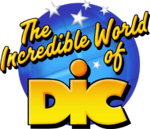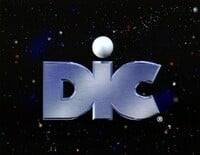DIC Entertainment
| DIC Entertainment | |
|---|---|

| |
| Founded | 1971[?] |
| Defunct | December 6, 2008[?] |
| First Super Mario TV show | The Super Mario Bros. Super Show! |
| Latest Super Mario TV show | Mario All Stars |
| Current president | Andy Heyward |
DIC Entertainment (stylized as DiC Entertainment), often shortened to DIC and pronounced "deek," was an animation company that created and licensed many programs, including Inspector Gadget, Heathcliff, Sailor Moon, and The Real Ghostbusters.
DIC also produced a number of licensed animated series based on video games. In addition to shows such as the three original Sonic the Hedgehog cartoons (Adventures of Sonic the Hedgehog, Sonic the Hedgehog, and Sonic Underground), Double Dragon, and Where on Earth Is Carmen Sandiego?, DIC was responsible for the three animated shows of the Super Mario franchise, as well as other closely related shows such as Captain N: The Game Master and The Legend of Zelda.
History[edit]
DIC was started in 1971 by Jean Chalopin in France, as Diffusion, Information and Commercial, a subsidiary of Radio-Television Luxembourg. Chalopin found international coproductions advantageous for animation,[1] gaining acclaim for France-Japan partnerships like Ulysses 31 and The Mysterious Cities of Gold.
The company's American headquarters were established in 1982 in Burbank, California. Managed by former Hanna-Barbera writer Andy Heyward, DIC's United States division opened with a major success in the form of Inspector Gadget. The company also successfully entered the market for tie-in cartoons for action figure lines with shows such as M.A.S.K., Jayce and the Wheeled Warriors, and C.O.P.S. DIC's success during this period was attributed by commentators and its competitors to its outsourcing of the animation process to Japanese studios[1] before the practice became popular for United States production companies, aggressive merchandising deals, and low wages (for instance, DIC paid storyboard artists half the salary of its unionized competitors[2]).
In December 1986,[3] Heyward bought DIC from Chalopin, making the company purely American-owned (although Chalopin would retain the original Luxembourg office and continue to produce animated series as C&D). The acquisition was expensive (an article by the LA Times stated the company was $70 million in debt as a result of the transaction[4]), leading to cost-cutting measures for DIC's following shows. These measures included outsourcing animation to cheaper South Korean and Chinese animation studios such as Sei Young and Pacific Rim, aggressively discouraging attempts to unionize, and having most voice acting recorded in Canada due to the favorable exchange rate. This lead to DIC getting derisive nicknames such as "Do it cheap" or "Done in China" in the animation industry, although others noted DIC's loose structure made it an effective training ground for aspiring animators, with many of its former employees becoming successful in the business.[5]
During this period, DIC heavily invested in animated adaptations of existing media franchises, including video games. When asked about this trend, executive Robby London explained that while not all employees of DIC's liked the company's focus on adapting existing properties, video games were the company's favorite medium to adapt because "[...] the videogames themselves were colourful, imaginative, hip and more than a little bizarre – in the best sense" and that the sparse lore and simple characters in games of the time allowed for more creativity than when adapting material from other media.[6] Heyward approached Nintendo with a proposal to make an animated series based on the games of the Super Mario franchise, and after some initial reticence,[7] he managed to convince Nintendo. Aside from approving DIC's decisions,[8] Nintendo generally took a hands-off role in the production of these series; when asked, neither Robby London[6] nor the Super Mario cartoons' producer-director John Grusd[8] remembered any instances of intervention from Nintendo. London in particular praised Nintendo of America's professionalism and contrasted it with DIC's more difficult dealings with Sega for its three Sonic the Hedgehog animated series.[6]
On July 23, 2008, DIC was acquired by and folded into Cookie Jar Entertainment. Cookie Jar, and by extension DIC's portfolio, was then acquired by WildBrain (formerly known as DHX Media) in 2012. After the end of his one-year contract with Cookie Jar, Heyward started a new company named A Squared Entertainment (now Genius Brands) with fellow DIC executives Robby London and Michael Maliani. As a result of the acquisition, future home video, streaming, and YouTube releases of all Super Mario cartoons replace the company's logo with Cookie Jar's logo. At times, particularly the YouTube uploads of some episodes of The Super Mario Bros. Super Show! that were uploaded to the show's YouTube channel in 2018, they use the masters of the episodes that were used in the North American DVD releases predating the company's acquisition, as well as retaining the previews of the television series The Legend of Zelda, all of the live-action segments, and the Viacom logo.
Super Mario franchise produced by DIC[edit]
- The Super Mario Bros. Super Show! – September 4, 1989–December 1, 1989
- Club Mario – Summer 1990
- King Koopa's Kool Kartoons – Holiday 1989
- The Adventures of Super Mario Bros. 3 – September 8, 1990–December 1, 1990
- Super Mario World – September 13, 1991–December 7, 1991
- Captain N & The Video Game Masters – 1992
- Mario All Stars – 1994
Notable employees[edit]
Gallery[edit]
The company’s logo in a poster featuring various cartoon characters, including its mascot, Inspector Gadget
References[edit]
- ^ a b Akst, Daniel (May 28, 1985). "DIC Enterprises Emerges as Animation Industry Giant : Studio City Firm Changing Saturday Mornings". Retrieved March 10, 2017
- ^ Animation Guild (June 5, 2010). "A Few Words About Non-Union Studios and Organizing". TAG Blog. Retrieved March 20, 2013).
- ^ Adelson, Andrea (December 30 1987). BUSINESS PEOPLE; For Maker of Cartoons, A Chance to Go Public. NY Times. Retrieved March 10, 2017
- ^ Bates, James (March 8, 1988). Huge Debt Keeps Pressure on DIC to Keep Turning Out Animated TV Hits : Cartoon Firm Deals Way to Top. LA Times. Retrieved March 10, 2017.
- ^ Mallory, Michael (August 23, 2013). "The University of DIC". Animation Magazine. Retrieved July 10, 2016
- ^ a b c GamesTM. "From Captain N to Sonic Underground: Behind videogames' earliest cartoons. Retrieved September 13, 2016
- ^ Canoe: Super Mario Bros. Super Show hit a high score
- ^ a b John Grusd interview (May 25, 2016). Super Mario Boards. Retrieved July 30, 2016


